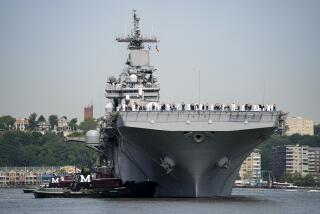Gulf Crisis Exposed U.S. Deployment Flaws, Official Says
- Share via
The Persian Gulf crisis has exposed this nation’s shortcomings in quickly deploying a sizable military sea lift without the considerable assistance of other nations, the head of the U.S. Maritime Administration said Wednesday.
Further, Capt. Warren G. Leback warned that without the unprecedented commitment of foreign-flagged ships, it would have taken until now for the United States to muster enough cargo vessels to adequately supply the 250,000 troops massing in the Middle East. And even now, he said, the U.S. sea lift would face a struggle supplying the troops if a conflict erupts.
“As long as we don’t start shooting, everything’s fine,” Leback told a Long Beach luncheon crowd. “But to go to the next step, we’re short. There’s no question.”
In an interview, Leback added that the lessons of the Middle East deployment, Operation Desert Shield, will certainly include a reassessment of the nation’s military sea lift capability and the need for committing as much as $1 billion over the next four to five years for maintaining and testing a reserve fleet of cargo ships.
“If it was not a global effort, we’re not sure we would have had the availability of the vessels” needed for Operation Desert Shield, Leback said after his appearance before the local chapter of the Propeller Club of the United States, a nonprofit maritime association.
Leback’s remarks follow weeks of attention by Congress and the Bush Administration to the nation’s sea lift capabilities and particularly the Maritime Administration’s Ready Reserve Force. The 96-ship force was established in 1976 to support military operations and consists of retired commercial vessels maintained by the Transportation Department, which oversees the Maritime Administration.
Since the crisis began there has been criticism of the reliance on foreign-flagged ships to support U.S. troops and of delays--some as long as 20 days--in deploying the 45 Ready Reserve Force vessels that are taking supplies to the Mideast.
Though Administration and Pentagon officials have emphasized the size of Operation Desert Shield, they have also acknowledged, as Leback did Thursday, that years of federal neglect of the nation’s maritime readiness must end if the United States is to sufficiently support its military in a crisis.
Specifically, Leback said, the Persian Gulf crisis demonstrated that the nation’s Ready Reserve Force fleet did not meet its established goal of dispatching the vessels in as little as five days in a military deployment. Previously, officials reported that only 14 of the ships activated in Operation Desert Shield reached their ports for loading on schedule, with the remaining ships arriving one to 20 days late.
Moreover, Leback pointed out the U.S. sea lift to the Persian Gulf relied heavily on foreign-flagged vessels whose support cannot be assured in the future. Had those 70 or so foreign vessels not been available, Leback said, the United States might have been forced not only to call up its remaining 51 Ready Reserve Force ships, with delays of up to 30 days, but other, older ships in the so-called National Defense Reserve Fleet, whose deployment could have taken two to four months. (Some of the National Defense Reserve Fleet vessels have been mothballed for 10 years.)
And that scenario, Leback said, would have left the United States unable to swiftly provide the hundreds of thousands of tons of military equipment and cargo needed to support the nation’s troops in Saudi Arabia. “We wouldn’t have been able to put the armor and equipment needed to match the troop lift in order to deter the Iraqis,” Leback said.
Since the problems with the Ready Reserve Force became apparent, Leback and other Administration officials have emphasized the great demands on sea lift in the past three months. The operation has required, for example, the delivery of 50% more equipment and supplies in the first month of operation than during the first month of the Korean War.
At the same time, officials have acknowledged there can be no excuses for slow deployment in a military crisis. And that, Leback said Thursday, will be the argument for immediately increasing funds to the reserve fleet, whose budget was cut last year from $171 million to $89 million.
“It doesn’t make sense in one year when we are in an emergency situation, or whatever you want to call it, to get all kinds of money,” Leback said. “We need to put the ready back into the ready reserve.”
More to Read
Sign up for Essential California
The most important California stories and recommendations in your inbox every morning.
You may occasionally receive promotional content from the Los Angeles Times.













